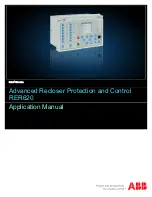
BE1-951
Testing and Maintenance
13-1
SECTION 13 • TESTING AND MAINTENANCE
GENERAL
The need to test protective relays to confirm performance as designed by relay manufacturers has always
existed. However, numeric relay design is changing the industry testing paradigms that have been in use
since the first protective relay was built. Each time a fault occurs, the numeric protection system is tested,
and as a result of its fault and event recording capability, the test is also documented. In the unlikely event
of a protection system problem, continuos monitoring along with remote communications capability provide
for removing the affected relay from service, auto switching to backup systems, and immediate notification
of a manned facility. These features have virtually eliminated the need for periodic maintenance. Simple
acceptance tests that verify the integrity of the relays measuring circuits and commissioning tests that verify
the relays "electronic wiring" (control logic) are Basler Electric's recommended pre-installation tests.
This section provides guidelines for performing these tests and others. It also provides guidelines for care,
handling, and troubleshooting of the BE1-951 relay. For assistance in conducting relay self-tests and
troubleshooting using internal diagnostics, contact Basler Electric Technical Support Services.
TESTING PHILOSOPHIES
Testing is generally divided into the following categories:
Acceptance
Commissioning
Periodic (user scheduled maintenance)
Functional
While all types of tests may be performed, all users do not generally perform them. Likewise, the degree
to which you will conduct each type of test depends on need, economics, and perceived system value.
Acceptance Testing
Acceptance testing is intended to confirm that a particular relay delivered to a customer meets published
specifications. Because this is a numerical relay whose characteristics are defined by software, Basler
Electric does not require the user to test each operational setting in the relay. Successful completion of the
Acceptance Test verifies proper response of the relay's input and output circuits as well as its response to
all external sensing input quantities (voltage, current, frequency).
Basler Electric performs detailed acceptance testing on all devices to verify all functions meet published
specifications. All products are packaged and shipped with the strictest of standards. The BE1-951 relay is
a microprocessor-based relay whose operating characteristics will not change over time. The relay will also
not experience any change in operating characteristics during transit. However, it remains material that the
user perform these acceptance tests to verify the device has not suffered any degradation in transit. Basler
Electric warrants all products against any decay in performance outside of the published specified tolerances
that result from problems created during transit.
Commissioning Testing
Commissioning testing verifies all physical connections and functional aspects of the protective relay for a
new installation. This includes a thorough review and documentation of the operational settings to verify that
the users calculated values match the actual values on each enabled protection element of the relay. All
of the following connections or functions can be verified during commissioning tests:
Proper connection and sensing of current and voltage signals as applicable
Connections of I/O contacts
I/O sensing versus virtual sensing
Setting validation
Proper operation of equipment (main or auxiliary)
Proper alarming (to SCADA) and/or targeting















































